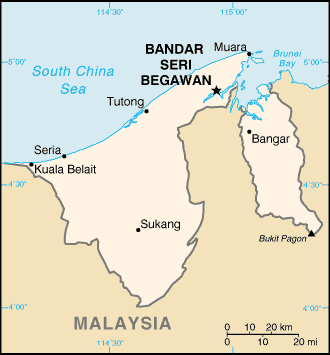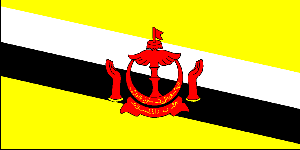
|
Brunei
Background:
The Sultanate of Brunei's heyday occurred between the 15th and 17th centuries,
when its control extended over coastal areas of northwest Borneo and the
southern Philippines. Brunei subsequently entered a period of decline brought
on by internal strife over royal succession, colonial expansion of European
powers, and piracy. In 1888, Brunei became a British protectorate; independence
was achieved in 1984. Brunei benefits from extensive petroleum and natural gas
fields, the source of one of the highest per capita GDPs in the less developed
countries. The same family has now ruled Brunei for over six centuries.
Location:
Southeastern Asia, bordering the South China Sea and Malaysia.
Area: Total: 5,770 sq km, water: 500 sq km, land: 5,270 sq km.
Area - comparative: Slightly smaller than Delaware.
Land boundaries: Total: 381 km, border countries: Malaysia 381 km.
Coastline: 161 km.
Climate and Terrain:
Climate: Tropical; hot, humid, rainy.
Terrain: Flat coastal plain rises to mountains in east; hilly lowland in west.
Elevation extremes: Lowest point: South China Sea 0 m highest point: Bukit
Pagon 1,850 m
Natural resources: Petroleum, natural gas, timber
People:
Population: 350,898.
Ethnic groups: Malay 67%, Chinese 15%, indigenous 6%, other 12%.
Religions: Muslim (official) 67%, Buddhist 13%, Christian 10%, indigenous
beliefs and other 10%.
Languages: Malay (official), English, Chinese.
Government:
Government type: Constitutional sultanate.
Capital: Bandar Seri Begawan.
Independence: 1 January 1984 (from UK.)
Economy overview:
This small, wealthy economy is a mixture of foreign and domestic
entrepreneurship, government regulation, welfare measures, and village
tradition. Crude oil and natural gas production account for nearly half of GDP.
Per capita GDP is far above most other Third World countries, and substantial
income from overseas investment supplements income from domestic production.
The government provides for all medical services and subsidizes rice and
housing. Brunei's leaders are concerned that steadily increased integration in
the world economy will undermine internal social cohesion although it became a
more prominent player by serving as chairman for the 2000 APEC (Asian Pacific
Economic Cooperation) forum.
GDP - composition by sector: Agriculture: 5% industry: 45% services: 50%.
Statistics:
Telephones - main lines in use: 79,000.
Telephones - mobile cellular: 43,524.
Radio broadcast stations: AM 3, FM 10.
Radios: 329,000.
Television broadcast stations: 2.
Televisions: 201,900.
Internet users: 28,000.
Railways: Total: 13 km.
Highways: Total: 1,712 km, paved: 1,284 km, unpaved: 428 km.
Airports: 2 (2001)
Airports - with paved runways: 1, with unpaved runways: 1.
Return to Visiting Locations
|

